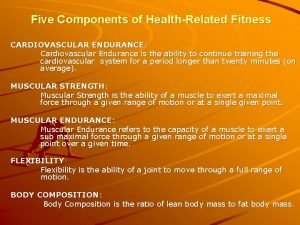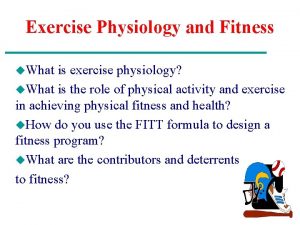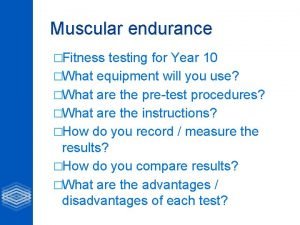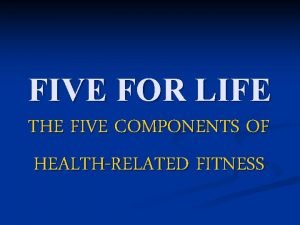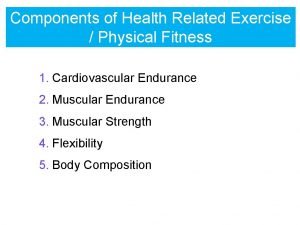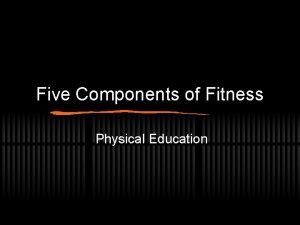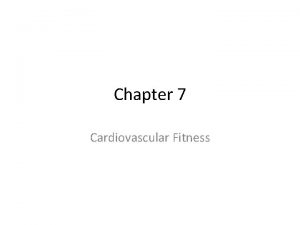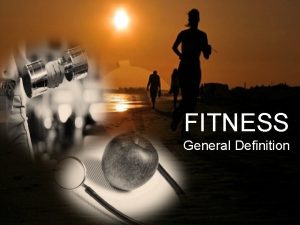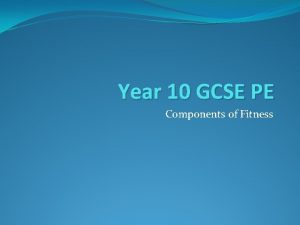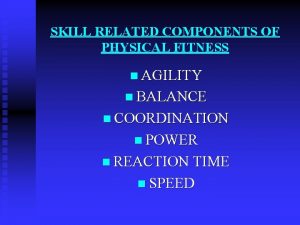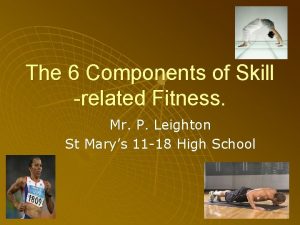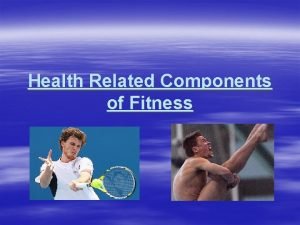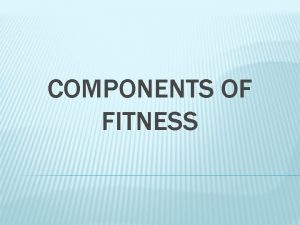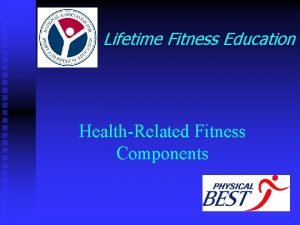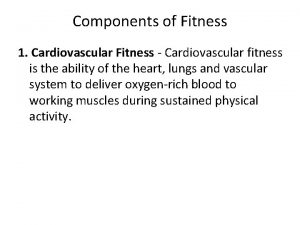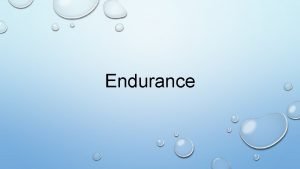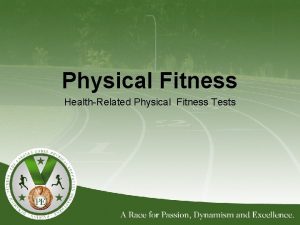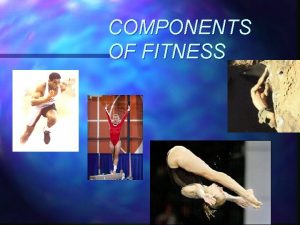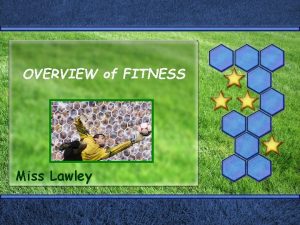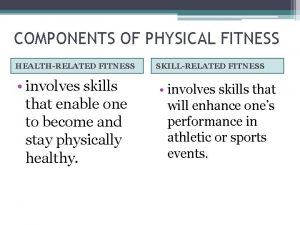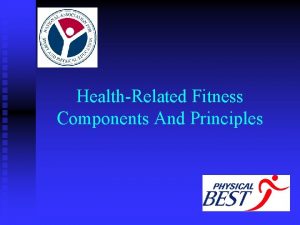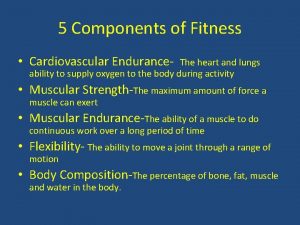Five Components of HealthRelated Fitness CARDIOVASCULAR ENDURANCE Cardiovascular















- Slides: 15

Five Components of Health-Related Fitness CARDIOVASCULAR ENDURANCE: Cardiovascular Endurance is the ability to continue training the cardiovascular system for a period longer than twenty minutes (on average). MUSCULAR STRENGTH: Muscular Strength is the ability of a muscle to exert a maximal force through a given range of motion or at a single given point. MUSCULAR ENDURANCE: Muscular Endurance refers to the capacity of a muscle to exert a sub maximal force through a given range of motion or at a single point over a given time. FLEXIBILITY: Flexibility is the ability of a joint to move through a full range of motion. BODY COMPOSITION: Body Composition is the ratio of lean body mass to fat body mass.

ASSESS YOUR FITNESS LEVEL For you to effectively assess your fitness level, it is necessary to consider the five components of fitness. That is why we completed the Pre-Fitness Test to give us a baseline of where we are at with our fitness level. Knowing where we are at will help us to structure an exercise program that will develop our optimal fitness levels and reduce body fat. This means more than how far you can run, or how much weight you can lift. Optimal fitness is evident in everyday life and the stamina in dealing with day to day activities.

CARDIORESPIRATORY ENDURANCE Of the 5 components, cardiovascular fitness is the cornerstone that creates the pathway to improving your other fitness levels. It is the ability of your heart and lungs to work together to provide the necessary oxygen and fuel to your body without quickly reaching a high level of fatigue and tiredness. In our daily lives, we need cardiovascular fitness to handle the physical tasks and all of the “running around” we do.

MUSCULAR STRENGTH Muscular strength is quite the opposite of cardiovascular fitness in regards to the fact that cardiovascular fitness is measured over a certain period of time. While on the other hand, muscular strength is measured in one repetition. In our daily lives, we need modest levels of strength to be able to perform everyday physical tasks like lifting, moving, carrying, etc.

MUSCULAR ENDURANCE To put it simplistically, it’s how long your muscles can do something before getting too exhausted to finish.

FLEXIBILITY Flexibility is actually more important to physical fitness than people realize. Not only does flexibility play a big role in performing many daily tasks, but maintaining or even increasing your flexibility is critical to protecting your joints and keeping them healthy. Stretching is the best way to improve flexibility. And, most fitness experts recommend a daily routine of static stretches for each joint.

BODY COMPOSITION Body composition is a better indicator of your overall fitness condition than body weight. So understand that your total body weight or what you see on your bathroom scale does not tell you how much fat or lean body mass (muscle) you have. Body composition is useful in helping to determine health risks. Therefore, knowing your body composition and how it relates to your overall fitness level is essential. An optimal ratio of fat mass to lean mass is a clear indicator of good fitness. Hydrostatic Weighing BMI is an index of a person's weight in relation to height, not body composition.

SKILL RELATED FITNESS Agility – The ability to change the position of your body and to control the movement of your whole body. Balance – The ability to keep an upright posture while either standing still or moving. Power – The ability to perform with strength at a rapid pace. Reaction Time – The amount of time it takes to start a movement once your senses signal the need to move. Coordination – The integration of eye, hand, and foot movements. Speed – The ability to cover a distance in a short time.

AGILITY This is an important quality in many sports, because you must change direction rapidly and always have your body under control.

BALANCE Good balance is essential to being successful in activities such as:

POWER Strength and speed are both involved in power. Examples of athletes who typically have a high degree of power are:

REACTION TIME People with a good reaction time can usually start quickly in track and swimming or react quickly in pingpong or karate.

COORDINATION This component is necessary for success in such sports as:

Speed is very important factor in many sports activities. SPEED

CHARACTER TRAITS Honesty Respect Trustworthy Dependable Hard worker Integrity Maturity Pride James Braddock
 Halimbawa ng cardiovascular endurance
Halimbawa ng cardiovascular endurance Fitness u
Fitness u Mapeh (physical education grade 7)
Mapeh (physical education grade 7) Muscular endurance fitness test
Muscular endurance fitness test Five for life
Five for life Health related components definition
Health related components definition Five components of fitness
Five components of fitness Fitness chapter 7
Fitness chapter 7 Skill related fitness vs health related fitness
Skill related fitness vs health related fitness Components of fitness definition
Components of fitness definition Illinois agility test gcse pe
Illinois agility test gcse pe Ability to move body parts swiftly
Ability to move body parts swiftly 6 components of skill-related fitness.
6 components of skill-related fitness. Components of health related fitness
Components of health related fitness 2 types of fitness
2 types of fitness Components of fitness
Components of fitness
